User-generated content (UGC) has evolved into one of the most powerful tools for brands to engage their audience, build trust, and enhance visibility. It’s a strategy where customers create and share content that features a brand, product, or service, often without financial compensation, leveraging the authenticity of real-life experiences. Today, it’s more relevant than ever in the digital marketing landscape.
Why Is UGC Important?
User Generated Content adds authenticity to a brand’s marketing efforts. According to studies, 85% of people trust UGC more than content created directly by brands. It’s no surprise, then, that brands like CeraVe and Alpenglow have seen dramatic growth thanks to User Generated Content. For example, after skincare influencer Hyram posted about CeraVe, the brand’s sales skyrocketed, and the buzz continued to grow across platforms. Similarly, Alpenglow, a photography app, experienced a 500% increase in traffic and revenue after a TikTok user’s video featuring the app went viral.
This level of authenticity is hard to replicate through traditional advertising methods. Consumers value real feedback from other users more than they do polished marketing campaigns, making User Generated Content an invaluable trust-builder.
The Benefits of User Generated Content
- Builds Community: UGC allows your customers to actively participate in your brand’s story. For example, brands like Fenty Beauty and Aritzia regularly reshare their followers’ posts, fostering a sense of community and belonging.
- Cost-Effective: Unlike influencer marketing, which often requires substantial investment, UGC is organic and typically free for brands. The content comes directly from customers who are excited to share their experiences.
- Improves Engagement and Reach: User Generated Content drives engagement through likes, shares, and comments, while also extending a brand’s reach across different platforms. A simple hashtag campaign like Urban Outfitters’ #UOCommunity encourages customers to tag their photos, resulting in continuous streams of fresh content
Real-Life Examples of UGC
- Maybelline & TikTok
Maybelline’s success with UGC on TikTok exemplifies the platform’s power in creating viral moments. Their product went viral after a user’s video showcased how to use it effectively, resulting in sold-out items across several locations. - The Pink Stuff
This cleaning product achieved viral status on TikTok thanks to a user-created video demonstrating its effectiveness. As a result, the brand enjoyed a massive surge in sales, all thanks to the organic reach of User Generated Content.
How to Leverage User Generated Content

- Encourage Customers to Share Content
The first step is simple: ask! Many consumers are eager to share their experiences but might need a nudge. Brands can start by creating engaging hashtag campaigns or photo contests. For example, ELF Cosmetics launched the viral #EyesLipsFace challenge, which led to millions of videos being created by users. - Reward UGC Creators
Offer incentives like discounts, shout-outs, or features on your brand’s social media pages. Brands like Fenty Beauty have used giveaways to inspire users to create content, offering prizes to those who use specific branded sounds or hashtags in their videos. - Use Tools to Find UGC
Brands can use tools like Tagboard or Talkwalker to discover relevant user-generated content through hashtags, allowing them to easily curate and share customer-made content. These tools help sift through large amounts of content to find User Generated Content that aligns with your brand’s messaging.
Trends in UGC
- UGC and AI
Artificial intelligence is revolutionizing UGC by analyzing trends and helping brands identify what resonates with their audience. AI can also automate the collection of UGC by scanning social media platforms for brand mentions, images, and reviews. - Video Content Dominance
With the rise of platforms like TikTok and Instagram Reels, video UGC has taken center stage. Brands are encouraging customers to create video content that demonstrates how they use products in their everyday lives, adding an extra layer of relatability and engagement. For example, Alpenglow’s virality on TikTok led to a significant increase in both app downloads and monthly revenue. - Employee-Generated Content
Some brands are turning to their own employees for User Generated Content. This can be particularly effective in industries where employees are well-versed in the product or service, offering behind-the-scenes glimpses that resonate with audiences. A notable example is Weber Shandwick, where 33% of employees actively post about their company without prompting.
How User Generated Ccontent Impacts SEO

UGC doesn’t just build trust—it can significantly improve SEO as well. User reviews, testimonials, and social media shares all contribute to a website’s authority, which Google recognizes and rewards with higher search rankings. Reviews on Google My Business, in particular, can lead to better local SEO performance, making it easier for potential customers to find your business.
Additionally, User Generated Content tends to generate a lot of backlinks, which further boosts a website’s SEO. When a user posts a review or shares your product, they are essentially acting as brand ambassadors, providing organic promotion and linking back to your site.
Measuring the Success of UGC Campaigns
To gauge the effectiveness of a UGC campaign, brands can track metrics like:
- Engagement Rate: Likes, shares, and comments on UGC posts.
- Reach: The number of people who saw the UGC content.
- Conversion Rate: Sales or sign-ups generated from UGC campaigns.
By monitoring these metrics, brands can fine-tune their UGC strategy, focusing on what works best to drive engagement and conversions.
Conclusion
User-generated content is not just a marketing trend; it’s a long-term strategy that builds trust, fosters community, and drives engagement. Whether it’s through a viral TikTok challenge or a simple hashtag campaign, UGC enables brands to showcase authentic content that resonates with audiences. With the right incentives and encouragement, UGC can be a cost-effective, powerful tool in your marketing arsenal, boosting both brand visibility and consumer trust.
As digital trends continue to evolve, incorporating User Generated Content into your strategy will keep your brand relevant, relatable, and trusted by customers. So, the next time you see a customer post about your product, don’t just like it—reshare it, celebrate it, and let it drive your brand forward.




